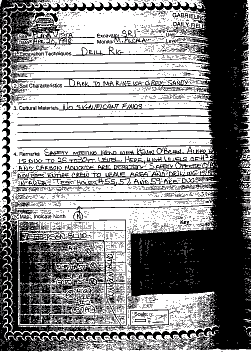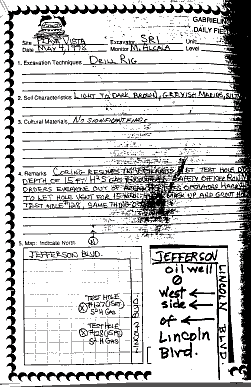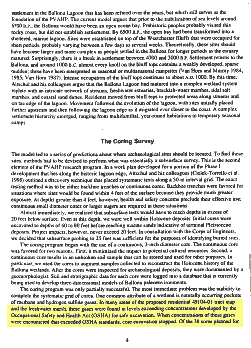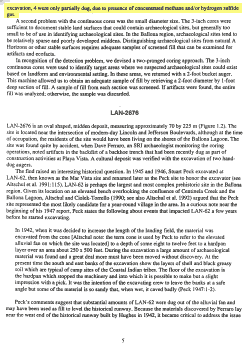Submitted on
PLAYA VISTA ALERTUnderground Gas Storage: 1998 Playa Vista Coring Log Books
The Log Books below are a small portion of the critical data that was withheld from the Los Angeles City environmental review of the Playa Vista site titled Chief Legislative Analyst Report (CLA Report) dated March, 2001. |
|||||
 |
|
THE COVER OF THE ARCHAEOLOGICAL AND HISTORICAL STUDY REPORT. In 1998, drilling was done on the Playa Vista site to determine if the area should be considered a significant archaeological site. During that drilling, dangerous levels of Hydrogen Sulfide gas were encountered - dangerous enough to stop drilling out of concern for the workers' safety. |
|||
|
|
|||||
 |
|
To the left is a page from the log dated April 20, 1998. The remarks section reads as follows:
"Safety meeting held with Kevin O'Brien. Auger hole is dug to 25 to 30 ft. level. Here, High levels of H2S and carbon monoxide are detected. Safety Officer O'Brien advises entire crew to leave area and drilling is suspended in area." Notes: H2S is the chemical symbol for Hydrogen Sulfide which is highly toxic even at very low levels. The map drawn on the page shows the testing is to be just south of Jefferson Blvd. and west of Lincoln Blvd. |
|||
|
|
|||||
 |
|
To the left is a page from the log dated May 4, 1998. The remarks section reads as follows:
"Coring resumes in wetlands. 1st test hole dug depth of 15 ft. H2S gas encountered. Safety Officer Ron M... orders everyone out of the area. He tells operators Harry... to let hole vent for 15 min. then mask up and grout hole. Test hole 128 same thing." |
|||
|
|
|||||
 |
|
The report of this drilling project is shown here to the left. The highlighted area reads:
"The coring program was only partially successful. The most immediate problem was the inability to complete the systematic grid of cores. One common attribute of a wetland is naturally occurring pockets of methane and hydrogen sulfide gases. In many areas of the proposed residential 49104-01 tract map and the freshwater marsh, these gases were found exceeding concentrations developed by the Occupational Safety and Health Act (OSHA) for safe excavation. When concentrations of these gases were encountered that exceeded OSHA standards, core excavation stopped. Of the 38 cores planned for excavation, 4 were only partially dug, due to presence of concentrated methane and/or hydrogen sulfide gas." |
|||
 |
|||||
- 2905 reads

